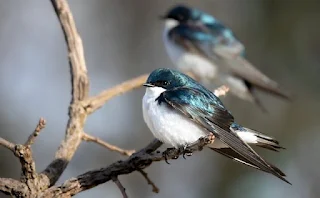Introduction to the Tree Swallow (Tachycineta bicolor)
The tree swallow (Tachycineta bicolor) is a remarkable bird species native to North America. Known for its vibrant blue plumage and graceful aerial acrobatics, these birds are a common sight across various regions of the continent.
In this article, we will delve into the fascinating world of tree swallows, exploring their habitat, behavior, migration patterns, and conservation efforts aimed at preserving their populations.
 |
| tree swallow |
Physical Characteristics and Habitat
Tree swallows are small passerine birds with distinctive physical characteristics. They measure approximately 5.5 to 6.7 inches in length and have a wingspan of 11 to 13 inches. Their striking appearance includes iridescent blue-green plumage on their backs, pure white underparts, and a slightly forked tail. These distinctive features make them easily recognizable in flight.
Behavior and Habitat: Tree swallows are cavity-nesting birds, which means they seek out natural or artificial tree cavities for nesting sites. They are highly adaptable when it comes to their habitat, as they can be found in a variety of environments, including wetlands, meadows, open woodlands, and even near human-made structures. These birds are particularly attracted to areas with an abundance of flying insects, which form the primary component of their diet.
Breeding Season: Tree swallows typically breed during the spring and early summer. They are known for their strong pair bonds and often return to the same nesting sites year after year. The female lays a clutch of four to seven white eggs, which she incubates for about two weeks. After hatching, both parents play an active role in feeding and caring for their nestlings.
Feeding and Diet
Tree swallows are insectivorous birds, and their diet primarily consists of flying insects. Their foraging behavior is characterized by their impressive aerial skills. They can be observed swooping and darting through the air to catch their prey. Some of the insects they commonly feed on include mosquitoes, flies, moths, and beetles.
Diet Variation: While insects make up the majority of their diet, tree swallows may also consume berries and other small fruits, especially during the late summer and fall when insect populations decline. This dietary flexibility allows them to adapt to changing food availability throughout the seasons.
Importance in Pest Control: Tree swallows play a crucial role in ecosystem health by helping control insect populations. In areas where these birds are abundant, they can significantly reduce the numbers of pest insects, providing a natural form of pest control that benefits both the environment and agriculture.
Migration Patterns
One of the most remarkable aspects of tree swallows is their annual migration. These birds exhibit a migratory behavior that takes them from their breeding grounds in North America to their wintering grounds in the southern United States, Mexico, and even Central America.
Migration Routes: Tree swallows typically begin their southward migration in late summer or early fall. They follow specific migratory routes known as flyways, which provide suitable stopover habitats for resting and refueling. The Eastern and Central Flyways are commonly used by tree swallows during their migration.
Benefits of Migration: Migration is essential for tree swallows to escape harsh winter conditions and find a more abundant food supply. It also allows them to avoid competition with other bird species that share their breeding grounds. Additionally, migration offers scientists valuable insights into the health and status of tree swallow populations, as researchers can track their movements using banding and tracking technologies.
Conservation and Threats
Tree swallows, like many other bird species, face several conservation challenges due to habitat loss, climate change, and human-related factors. Efforts are underway to protect and conserve these beautiful birds.
Habitat Preservation: The conservation of tree swallows often involves preserving their natural habitats and providing suitable nesting sites. This can be achieved by protecting wetlands, maintaining open grasslands, and installing nest boxes in areas where natural cavities are scarce.
Climate Change Impact: Climate change poses a threat to tree swallows, as it can disrupt their migratory patterns and alter the availability of insects in their breeding and wintering areas. Monitoring and research are crucial to understanding and mitigating these effects.
Pesticide Exposure: Pesticides used in agriculture can harm tree swallows indirectly by reducing insect populations, which are their primary food source. Advocacy for responsible pesticide use and the promotion of organic farming practices can help reduce this threat.
In conclusion, the tree swallow is a captivating bird species known for its beauty, aerial prowess, and valuable ecological role as insect predators. While they face conservation challenges, dedicated efforts are being made to ensure their continued presence in North America's ecosystems. These efforts highlight the importance of protecting both their breeding and wintering habitats, as well as addressing the broader environmental issues that affect their survival. By appreciating and safeguarding the tree swallow, we contribute to the preservation of biodiversity and the health of our natural world.

